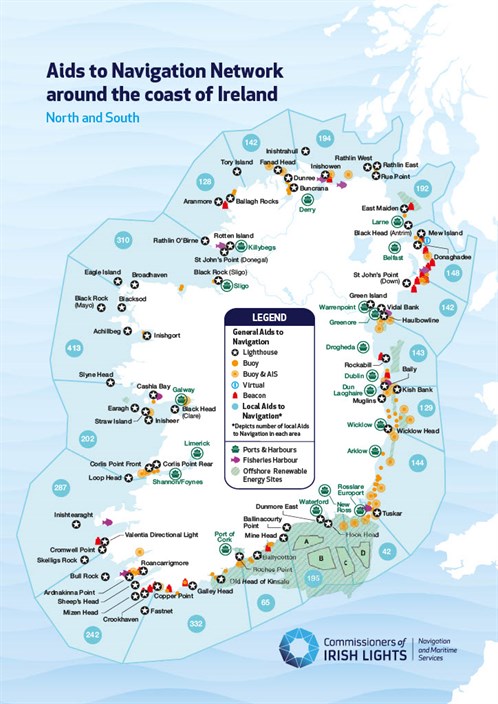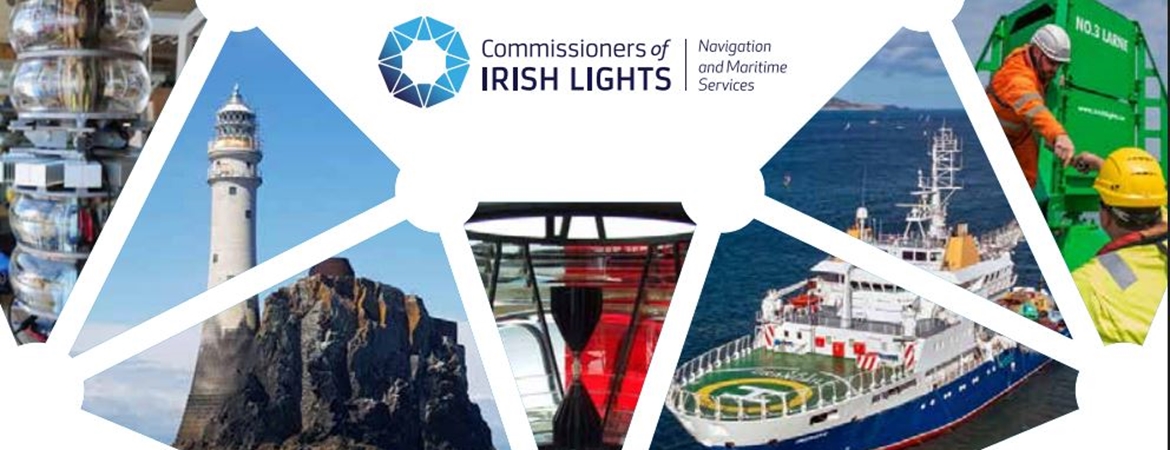‘Safe Seas – Connected Coasts’ 2025 – 2030, updates and refines the focus we had in the last strategy into five key areas of activity (Focus Areas). It underlines the primacy of our aids to navigation activity and strengthens our commitment to new activities, which were developed in the last five years and are demonstrating real potential and tangible results.
Irish Lights Aids to Navigation – A Critical National Infrastructure
Aids to Navigation (AtoN) provide a Critical National Infrastructure for the maritime sector due to their direct impact on the safety of navigation which facilitates commerce (with over 90% of goods transported by sea), protects lives, property, our seas and coastlines. Irish Lights provides a reliable, technologically advanced, fixed and floating infrastructure supporting associated data and monitoring services, which is essential for all who operate around the island of Ireland.
Irish Lights is and has been for over two centuries, a trusted provider of services and expertise to ensure safe navigation at sea around the island of Ireland, north and south. Retaining, growing and developing our expert and dedicated employees and ensuring our assets and infrastructure are operating effectively and reliably is critical to maritime safety around our coast. Our 2025-2030 strategy sets out clear goals and objectives and the allied activities, resources and infrastructure required to deliver this service.
Building on the platform of change that has been delivered over the last five years, Irish Lights is excited to chart the next stage of its evolution. We have developed five focus areas with associated strategic objectives and these objectives reflect the modern role of Irish Lights in delivering navigation, safety and allied maritime services and supporting the growth of the maritime economy.

Our 2025 – 2030 strategy is written in a period when the importance of secure international maritime supply chains is becoming better understood. Events such as the Covid-19 Pandemic, the Suez Canal closure, Brexit, and geo-political conflicts, have all highlighted the importance of safe, secure, and environmentally responsible maritime transport. Aids to Navigation and their integration into the wider suite of maritime safety and environmental services (that mariners rely on) have a critical role to play in supporting our maritime economy.
This strategy builds on the success of our 2018 - 2024 strategy and builds on a solid base of achievement, progress and continuity while taking account of some new and exciting drivers of strategic change. These include the shared and changing nature of the sea space around us, changes in technology, digitisation of services, the challenges of climate change and biodiversity and the evolution of regulations and standards. The heightened focus on offshore renewable energy and its strategic potential for Ireland is a case in point.
At the heart of this strategy is a commitment by Irish Lights to navigational safety at sea and around our coast, the adoption of effective and sustainable technologies, the protection and enhancement of our maritime environment and the sharing of our heritage with coastal communities. This is driven by our history, sense of place, our values, and our links to our user and stakeholder community. Building on our history and enduring values, we look forward, through the implementation of this strategy, to ensuring that Irish Lights continues to make a vital contribution to the maritime sector and the wider economy over the next five years and beyond.
The primary focus area for our strategy will always be Safe Navigation which reflects our core statutory safety functions and evolving industry, and maritime safety requirements linked to the strategic drivers of change.
To reflect the significance of Marine Spatial Planning and the National Marine Planning Framework as a co-ordinating context for marine planning, development and protection, we have introduced a new Focus Area to demonstrate the importance of Leadership, Collaboration and Alignment with related policies and organisations at national and international level.
In response to stakeholder feedback, we have elevated our actions on climate change and our commitment to sustainability, environment, and biodiversity. We maintain our commitment to the coastal communities in which we work and to safeguarding our heritage and developing the Great Lighthouses of Ireland all-island tourism initiative.
Delivering Excellence and our ongoing commitment to our Values reflects the importance we attach to our employees, their professionalism and expertise, and the delivery and development of our services in an agile, efficient, innovative and effective manner. We further benefit in this area from the sharing of expertise and resources with our sister organisations in Trinity House and the Northern Lighthouse Board and our shared General Lighthouse Authority Research and Development team.
DRIVERS OF STRATEGIC CHANGE
This strategy has been developed against a backdrop of change in the wider marine sector in Ireland and Northern Ireland recognising the critical importance of safe and efficient marine navigation to protect lives and promote the economy, trade, the environment and quality of life.
The strategy for the provision of Aids to Navigation is to ensure safe, efficient, and environmentally responsible navigation for all users. Our previous strategy (2018–2024 Safe Seas – Connected Coasts) focused heavily on driving innovation in service provision and building resilience into our aids to navigation systems to ensure safe navigation. These core objectives remain.
However, while there is continuity, there are also significant changes to the trends and drivers which inform this strategy. Irish Lights has identified nine key drivers of change that will influence this strategy over the period to 2030 and beyond.
Drivers of Strategic Change to 2030 and Beyond
- A Shared and Changing Sea Space
- Trade Patterns and Mix of Vessels
- The Future Mariner
- International and National Maritime Legislation, Standards and additional Compliance Requirements
- Changes in Technology
- Thought / Knowledge Leadership and Recognised Expertise on Navigation and Safety
- Sustainability, Climate Change, Environment and Biodiversity
- Maritime Safety and Security
- Key Asset Replacement and Contract Renewals



